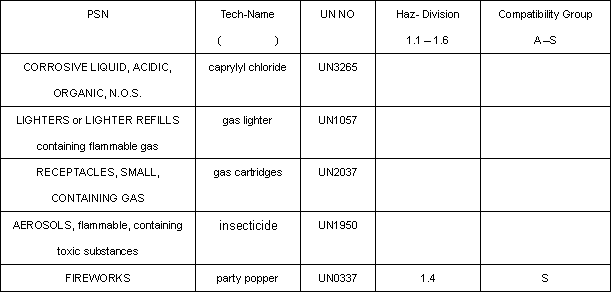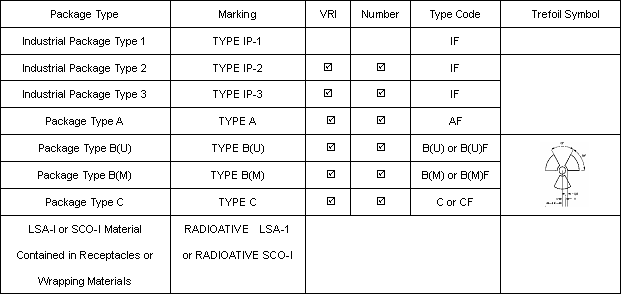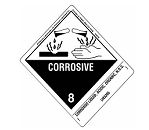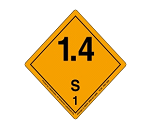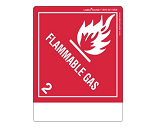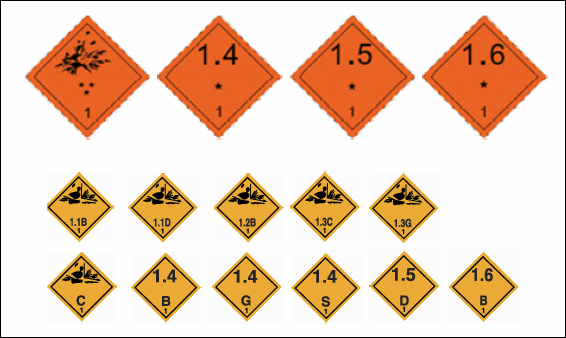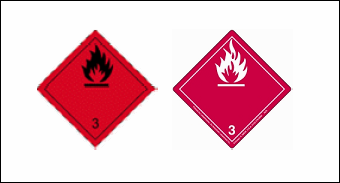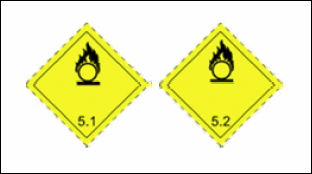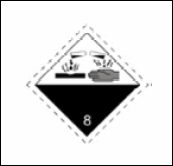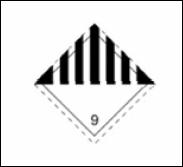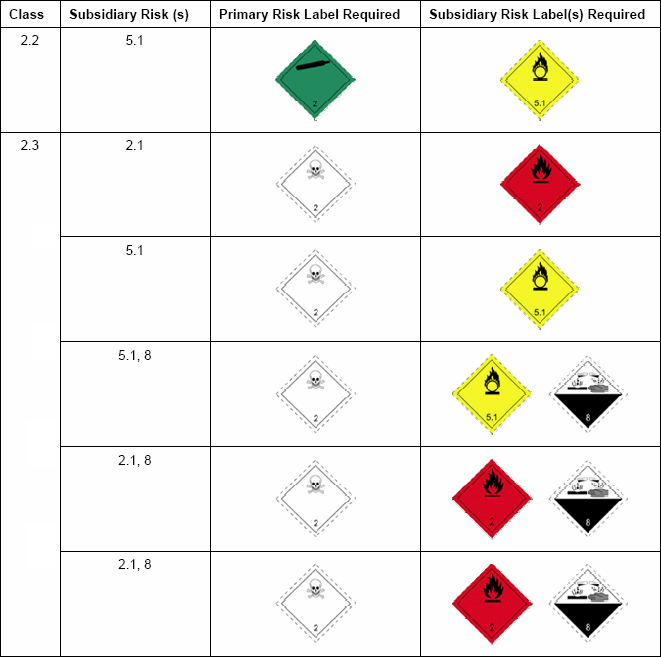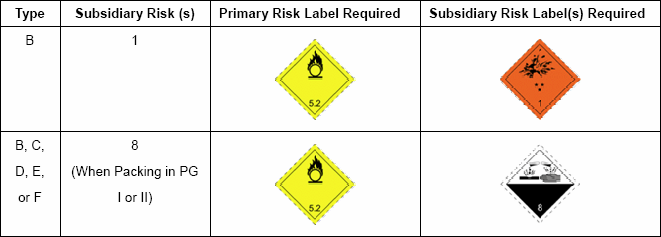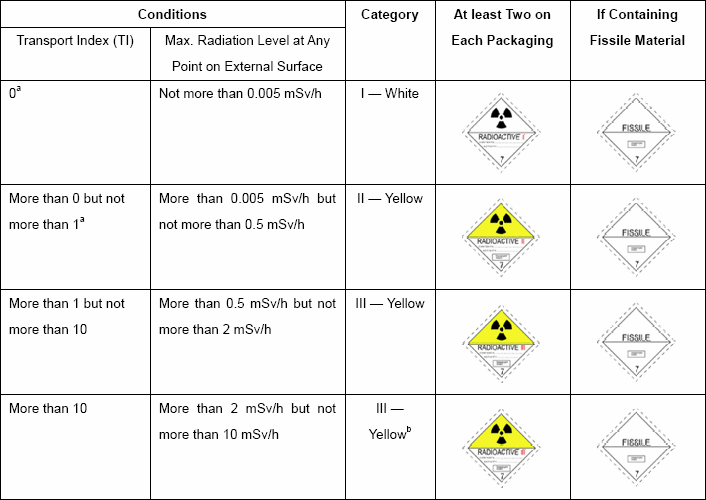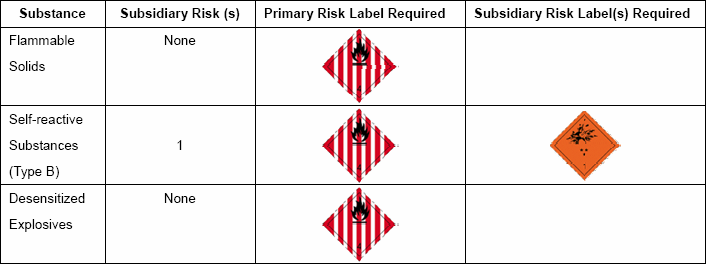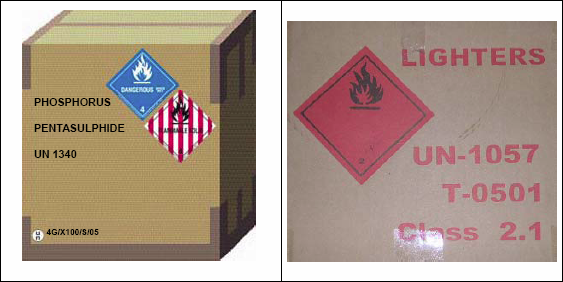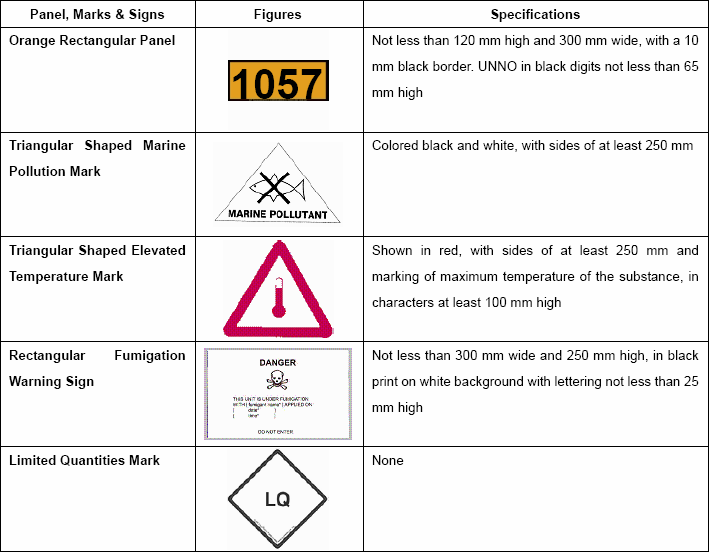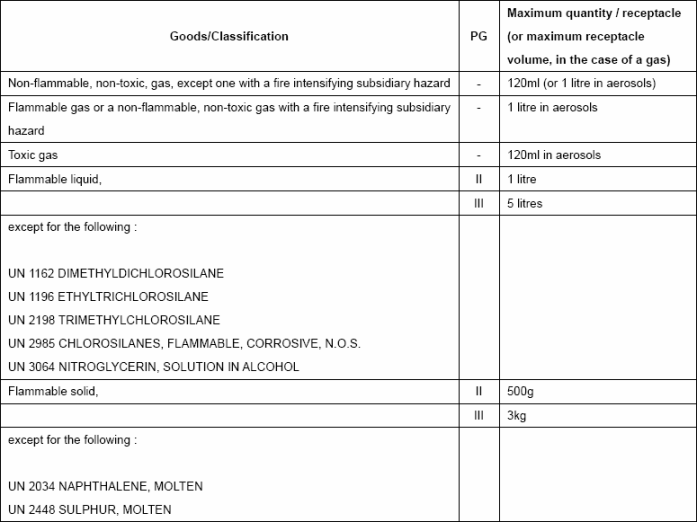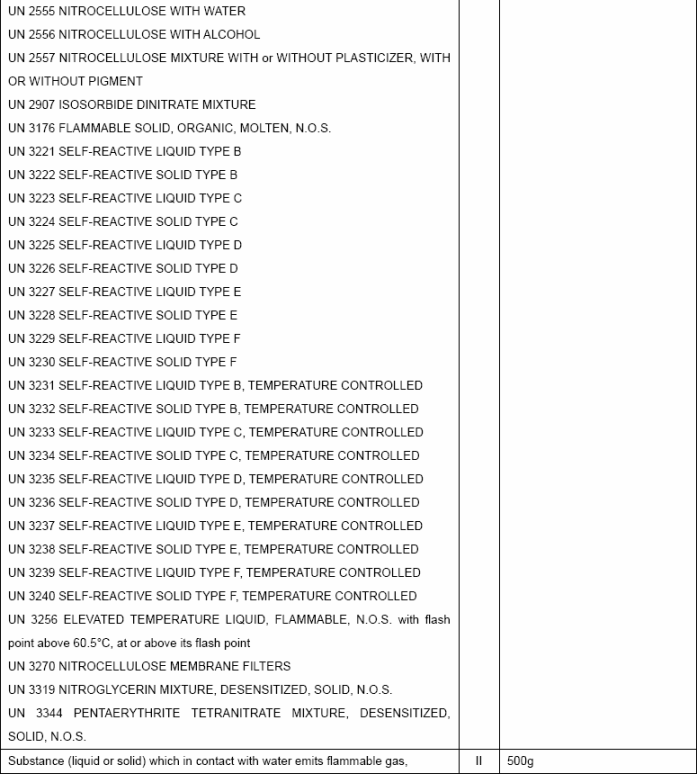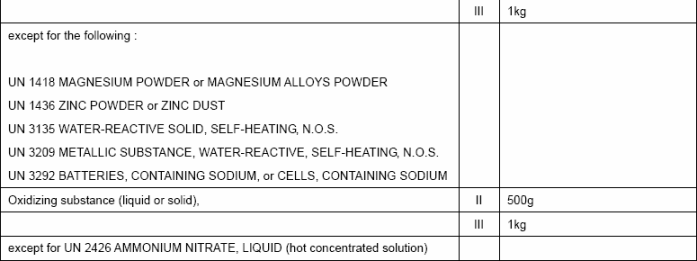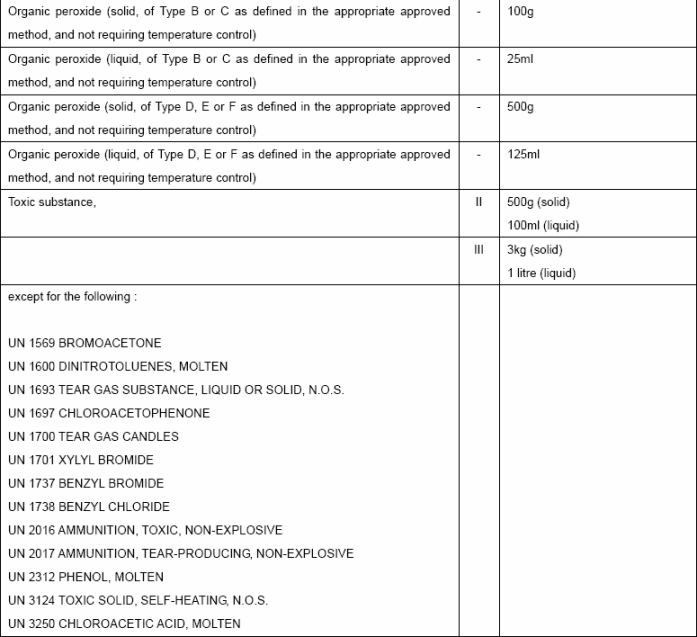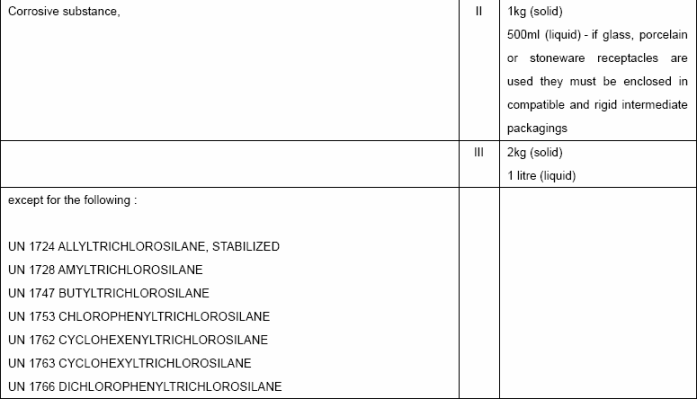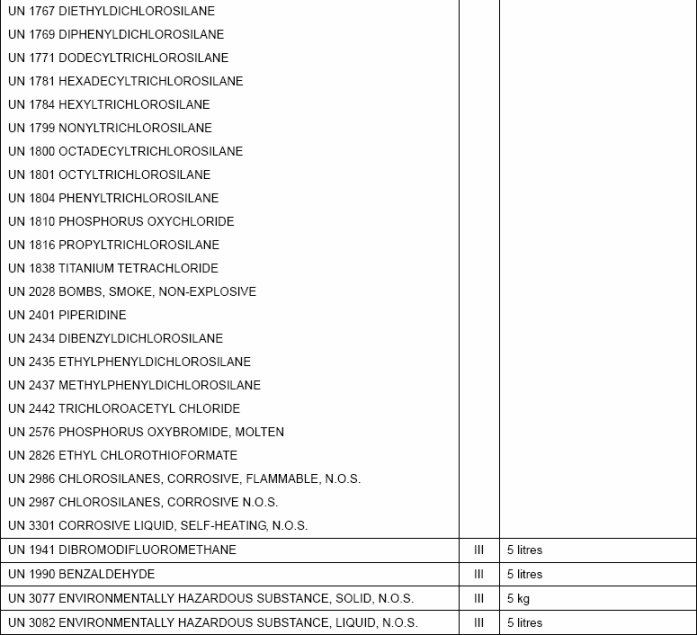| |
|
| |
|
1.0 Marking, Labeling & Warning
?
?
?
1.1 Marking of Packages including IBCs
?
?
1.1.1 IMDG Marking Requirements:
?
(a) For certain DGs, the PSN & the corresponding UN number, preceded by the letter ¡§UN¡¨, and the division and compatibility group letters, if applicable, should be marked on each package. In the case of unpackaged articles, the marking should be displayed on the article, on its cradle or on its handling, storage or launching device.
?
(b) High visibility, legibility and durability surviving at least 90-day immersion in the sea are required for marking.
?
(c) The word ¡§SALVAGE¡¨ should additionally be marked on salvage packagings.
?
(d) IBCs of more than 450L capacity should be marked on two opposing sides.
?
1.1.2 Typical Marks on Packages:
?
|
|
?
?
1.1.3 Special Marks for Class 7 on Packages, Receptacles or Wrapping Materials:
? |
|
| |
1.1.4 Special Marks for Marine Pollutants on Packages:
?
Packages containing a marine pollutant (for solutions, mixtures and isomers) should be marked with the Marine Pollutant Mark.
|
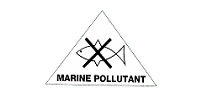 |
|
?
?
1.1.5 Examples of Display of Package Markings:
?
|
|
?
?
|
1.2 Labeling of Packages including IBCs
?
?
1.2.1 Wordless Labels of Class 1
?
|
|
?
????????????** Place for Division
????????????* Place for Compatibility Group
?
?
1.2.2 Wordless Labels of Class 2
? |
|
?
?
1.2.3 Wordless Labels of Class 3
? |
|
?
?
1.2.4 Wordless Labels of Class 4
? |
|
?
?
1.2.5 Wordless Labels of Class 5
? |
|
?
?
1.2.6 Wordless Labels of Class 6
? |
|
?
?
1.2.7 Wordless Labels of Class 7
? |
|
?
?
1.2.8 Wordless Labels of Class 8
? |
|
?
?
1.2.9 Wordless Labels of Class 9
? |
|
?
?
1.2.10 Text-inserted Label Samples
? |
| |
Worded |
4-Digit |
Worded with Imprinted Marks |
Worded with Blank Mark |
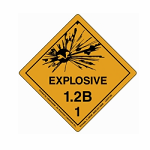
|
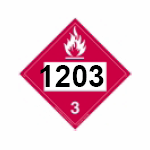 |
 |
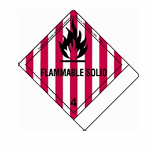 |
|
|
| |
|
| |
|
| |
|
|
?
?
1.2.11 Labeling for Refrigerated Liquefied Gases of Class 2 on Cryogenic Receptacles
?
|
The orientation label, rectangular, with a standard format 74 X 105 mm and two black or red arrows on white or suitable contrasting background shall be displayed on two opposite sides of cryogenic receptacles. |
 |
|
?
?
1.2.12 Labeling for Class 2 with Subsidiary Risk(s) on Packages
? |
|
?
?
1.2.13 Labeling for Class 5.2 with Subsidiary Risk(s) on Packages
? |
|
?
?
1.2.14 Labeling for Class 6.2 with Subsidiary Risk(s) on Packages
? |
In addition to the primary risk label, infectious substances packages should bear any other label required by the nature of contents. |
 |
|
?
?
1.2.15 Labeling for Class 7 on Packages, Overpacks or Freight Containers
? |
|
?
?
1.2.16 Labeling for Class 4.1 with Subsidiary Risk(s) on Packages
? |
|
?
?
1.2.17 Samples of Marking, Labeling on Packages Containing DGs
? |
|
?
?
?
1.3 Placarding and Marking of Cargo Transport Units
?
?
1.3.1 Placards (Enlarged Labels):
? |
|
?
?
1.3.2 Placards for Radioactive Material of Class 7:
? |
|
?
?
1.3.3 Orange Panel, Marks and Signs:
? |
|
| |
? ?
2.0 Quantity Limitations
? ?
|
Certain harmful substances may, for sound scientific and technical reasons need to be prohibited for transport (See Forbidden Substances) or be limited as to the quantity which may be carried aboard any one ship due to the size, construction and equipment of the ship, as well as the packaging and the inherent nature of the substances.
?
?
2.1 Weight Limitations
?
2.1.1 Dangerous goods transported in limited quantities should be packaged only in inner packagings placed in suitable outer packagings. The total gross mass of a package should not be exceeds 30 kg.
?
2.1.2 When shrink ¡V or stretch ¡V wrapped trays are acceptable as outer packagings for articles or inner packagings containing dangerous goods transported in limited quantities, the total gross mass of such a package should not be exceeds 20 kg.
?
2.1.3 Freight containers exceeding 6 m (20 ft) in length should not, except for goods of class 1 in division 1.4, carry more than 5,000 kg net mass of explosive substances of class 1.
?
2.1.4 ¡§AEROSOLS¡¨ (UN 1950) transported as limited quantities should not exceed 1,000 m3.
?
?
2.2 Exceptions for DGs Packed in Limited Quantities
?
|
|
?
?
?
3.0 Packing and Securing into CTUs
?
?
? ? |
3.1. General Requirements
?
?
3.1.1 Packages labelled as containing dangerous goods may be loaded -
?
????(a) in unsheeted, open large containers
????(b) in sheeted, open large containers;
????(c) in closed large containers;
????(d) in unsheeted, open wagons;
????(e) in sheeted, open wagons; or
????(f) in closed wagons.
??
3.1.2 Packages labelled as containing dangerous goods whose packagings are made
of materials sensitive to moisture shall be loaded in sheeted, open large
containers, sheeted, open wagons, closed large containers or closed
wagons.
??
3.1.3 Packages labelled as containing dangerous goods shall be protected against damage that may be caused by other packages.
??
3.1.4 Packages labelled as containing dangerous goods shall be loaded into large containers or wagons so that they cannot shift dangerously, tip over or fall.
??
3.1.5 Packages labelled as containing dangerous goods shall not be thrown or subjected to impact.
??
3.1.6 Packages labelled as containing dangerous goods of classes 4.1 (other than SELF-REACTIVE SUBSTANCES), 4.2, 4.3, 6.2 or 9 shall be loaded in sheeted, open large containers, sheeted, open wagons, closed wagons or closed large containers.
??
3.1.7 Packages labelled as containing SELF-REACTIVE SUBSTANCES or dangerous goods of class 5.2 shall be loaded in closed large containers or closed wagons with adequate ventilation.
??
?
3.2 Explosives (class 1)
|
| ?
3.2.1 No metal objects shall be allowed to protrude in the interior of any large container or wagon used for the carriage of explosives, other than those metal objects which form part of the construction of the large container or wagon concerned.
?
3.2.2 Explosive articles or substances in Division 1.1, 1.2, 1.3, 1.5 or 1.6, whether or not loaded in large containers, shall only be carried in wagons which have been fitted with regulation sheet steel spark-guards.
?
3.2.3 The regulation sheet steel spark-guards shall not be fixed directly to the floor of the wagon concerned where that floor is combustible.
?
3.2.4 Where packages containing -
????(a) explosive substances in Division 1.1 and Compatibility Group C, D or G;
????(b) explosive substances in Division 1.3 and Compatibility Group C or G; or
????(c) fireworks in Division 1.1, 1.2 or 1.3 and Compatibility Group G,
????
are being carried in a wagon or large container, the floor of the wagon or large container concerned shall have a non-metallic surface or covering.
????
???? ?
3.3 Gases: compressed, liquefied or dissolved under pressure (class 2)
?
3.3.1 Receptacles labelled as containing GASES: COMPRESSED, LIQUEFIED OR DISSOLVED UNDER PRESSURE shall be stowed in large containers or wagons in compliance with the following requirements -
?
????(a) cylinders with a capacity not exceeding 150 litres shall be laid parallel to or at right angles to the longitudinal axis of the large
????'???container or wagon, except that those situated near the end walls shall be laid at right angles to the said axis;
????(b) short cylinders of diameter 30 centimetres or over may be stowed longitudinally with their valve protective devices directed
???'???towards the middle of the large container or wagon;
????(c) cylinders which are sufficiently stable or which are carried in suitable devices which prevent them from overturning may be
???'???placed upright;
????(d) cylinders which are laid flat shall be so wedged, made fast or otherwise suitably and securely fixed that they cannot shift;
????(e) receptacles labelled as containing refrigerated liquefied gases shall always be placed in the position for which they were
???'`??designed and protected against any possibility of being damaged by other packages; and
????(f) receptacles designed to be rolled shall be laid with their longitudinal axis parallel to that of the large container or wagon and
?'''?`??shall be secured against any lateral movement.
????
3.3.2 Where pallets loaded with -
????
????(a) UN 1950 AEROSOLS, made of metal; or
????(b) UN 2037 RECEPTACLES, SMALL, CONTAINING GAS (GAS CARTRIDGES),
????
(grouped together in units on trays and sealed with a suitable plastic wrapping) are stacked, each tier of pallets shall be evenly distributed over the lower tier, if necessary by the interposition of a material of adequate strength.
????
????
3.4 Flammable solids (class 4.1)
????
3.4.1 Packages labelled as containing any of the following goods shall be loaded in large containers or wagons which are closely and adequately ventilated
????
|
| |
?UN 3221 |
?SELF-REACTIVE LIQUID TYPE B |
?UN 3222 |
?SELF-REACTIVE SOLID TYPE B |
?UN 3223 |
?SELF-REACTIVE LIQUID TYPE C |
?UN 3224 |
?SELF-REACTIVE SOLID TYPE C |
?UN 3225 |
?SELF-REACTIVE LIQUID TYPE D |
?UN 3226 |
?SELF-REACTIVE SOLID TYPE D |
?UN 3227 |
?SELF-REACTIVE LIQUID TYPE E |
?UN 3228 |
?SELF-REACTIVE SOLID TYPE E |
?UN 3229 |
?SELF-REACTIVE LIQUID TYPE F |
?UN 3230 |
?SELF-REACTIVE SOLID TYPE F |
|
|
|
| |
3.4.2 Large containers and wagons shall be thoroughly cleaned before they are
loaded with packages labelled as containing FLAMMABLE SOLIDS.
?
3.4.3 Packages labelled as containing FLAMMABLE SOLIDS, shall be loaded in -
?
????(a) sheeted, open large containers;
????(b) sheeted, open wagons;
????(c) closed large containers; or
????(d) closed wagons.
?
3.4.4 Packages labelled as containing FLAMMABLE SOLIDS and displaying the subsidiary hazard sign "liable to explosion" shall be loaded so that a free circulation of air within the loading space provides a uniform temperature for the load.
????
3.4.5 Where the contents of a large container or wagon exceed 5000 kg of packages labelled as containing FLAMMABLE SOLIDS and the packages display the subsidiary hazard sign "liable to explosion", the load shall be divided into stacks of not more than 5000 kg separated by air spaces of at least 0.05m.
????
3.4.6 Packages labelled as containing FLAMMABLE SOLIDS and displaying the subsidiary hazard sign "liable to explosion", whether or not loaded in large containers, shall only be carried in wagons which have been fitted with regulation sheet steel spark-guards.
????
3.4.7 The regulation sheet steel spark-guards referred to in sub-paragraph (7) shall not be fixed directly to the floor of the wagon concerned where that floor is combustible.
????
????
3.5 Substances which, in contact with water, emit flammable gases (class 4.3)
????
Where packages, labelled as containing substances which, in contact with water, emit flammable gases, are being carried in a large container or wagon, measures shall be taken to ensure that those packages do not come into contact with water.
????
????
3.6 Oxidizing substances (class 5.1)
????
3.6.1 Large containers and wagons shall be thoroughly cleaned and in particular be free of any combustible debris before they are loaded with packages labelled as containing OXIDIZING SUBSTANCES.
????
3.6.2 The use of straw or any other readily combustible material for stowing packages labelled as containing OXIDIZING SUBSTANCES is prohibited.
????
3.6.3 Where flexible intermediate bulk containers are used for the carriage of any of the following goods ¡V??
??????
|
| |
?UN 1442 |
?AMMONIUM PERCHLORATE |
?UN 1450 |
?BROMATES, INORGANIC, N.O.S. of packing group II |
?UN 1452 |
?CALCIUM CHLORATE |
?UN 1455 |
?CALCIUM PERCHLORATE |
?UN 1458 |
?CHLORATE AND BORATE MIXTURES |
?UN 1459 |
?CHLORATE AND MAGNESIUM CHLORIDE MIXTURE |
?UN 1461? |
?CHLORATES, INORGANIC, N.O.S. |
?UN 1473 |
?MAGNESIUM BROMATE |
?UN 1475 |
?MAGNESIUM PERCHLORATE |
?UN 1481 |
?PERCHLORATES, INORGANIC, N.O.S. |
?UN 1484 |
?POTASSIUM BROMATE |
?UN 1485 |
?POTASSIUM CHLORATE |
?UN 1489 |
?POTASSIUM PERCHLORATE |
?UN 1494 |
?SODIUM BROMATE |
?UN 1495 |
?SODIUM CHLORATE |
?UN 1502 |
?SODIUM PERCHLORATE |
?UN 1506 |
?STRONTIUM CHLORATE |
?UN 1508 |
?STRONTIUM PERCHLORATE |
?UN 1513 |
?ZINC CHLORATE |
?UN 2427 |
?POTASSIUM CHLORATE, AQUEOUS SOLUTION |
?UN 2428 |
?SODIUM CHLORATE, AQUEOUS SOLUTION |
?UN 2429 |
?CALCIUM CHLORATE, AQUEOUS SOLUTION |
?UN 2721 |
?COPPER CHLORATE |
?UN 2723 |
?MAGNESIUM CHLORATE |
?UN 3210 |
?CHLORATES, INORGANIC, AQUEOUS SOLUTION, N.O.S. |
?UN 3211 |
?PERCHLORATES, INORGANIC, AQUEOUS SOLUTION, N.O.S. |
?UN 3213 |
?BROMATES, INORGANIC, AQUEOUS SOLUTION, N.O.S. of packing group II |
|
|
|
|
? ????(a) they shall be carried in -
????
???????(i) a closed large container,
???????(ii) an open large container covered with an impermeable and non-combustible sheet,
???????(iii) a closed wagon,
???????(iv) a moveable-roof wagon, or
???????(v) an open wagon covered with an impermeable and non-combustible sheet; and
????
????(b) measures shall be taken to ensure that the goods cannot, in the event of a leak, come into contact with wood or any other
?????? combustible material.
3.6.4 Composite intermediate bulk containers containing any of the following goods, where those goods are in solid form, shall be carried in a closed wagon or a closed large container ¡V
????
|
| |
?UN 1479 |
?OXIDIZING SOLID, N.O.S. of packing group I |
?UN 1491 |
?POTASSIUM PEROXIDE |
?UN 1504 |
?SODIUM PEROXIDE |
?UN 2466 |
?POTASSIUM SUPEROXIDE |
?UN 2547 |
?SODIUM SUPEROXIDE. |
|
|
|
|
? ?
3.7 Organic peroxides (class 5.2)
?
3.7.1 Large containers and wagons shall be thoroughly cleaned before they are loaded with packages labelled as containing ORGANIC PEROXIDES.
?
3.7.2 Packages labelled as containing ORGANIC PEROXIDES shall be so loaded that a free circulation of air within the loading space ensures the uniform temperature of the load.
?
3.7.3 Where the contents of a large container or wagon exceed 5000 kg of packages labelled as containing ORGANIC PEROXIDES, the load shall be divided into stacks of not more than 5000 kg separated by air spaces of at least 0.05m.
?
3.7.4 The use of readily combustible material for stowing packages labelled as containing ORGANIC PEROXIDES in wagons or large containers is prohibited.
?
3.7.5 Packages labelled as containing ORGANIC PEROXIDES and displaying the subsidiary hazard sign "liable to explosion", whether or not loaded in large containers, shall only be carried in wagons which have been fitted with regulation sheet steel spark-guards.
?
3.7.6 The regulation sheet steel spark-guards shall not be fixed directly to the floor of the wagon concerned where that floor is combustible.
?
?
3.8 Toxic substances (class 6.1)
?
3.8.1 Composite or wooden intermediate bulk containers containing any of the following goods, where those goods are in solid form and of packing group I, shall be carried in a closed wagon or a closed large container ¡V
?
|
| |
?UN 1544 |
?ALKALOIDS, SOLID, N.O.S., or ALKALOID SALTS, SOLID, N.O.S. |
?UN 1557 |
?ARSENIC COMPOUND, SOLID, N.O.S. |
?UN 1570 |
?BRUCINE |
?UN 1601 |
?DISINFECTANT, SOLID, TOXIC, N.O.S. |
?UN 1655? |
?NICOTINE COMPOUND, SOLID, N.O.S. or NICOTINE PREPARATION, SOLID, N.O.S. |
?UN 1692 |
?STRYCHNINE or STRYCHNINE SALTS |
?UN 1693 |
?TEAR GAS SUBSTANCE, SOLID, N.O.S. |
?UN 1699 |
?DIPHENYLCHLOROARSINE |
?UN 2025 |
?MERCURY COMPOUND, SOLID, N.O.S. |
?UN 2026 |
?PHENYLMERCURIC COMPOUND, N.O.S. |
?UN 2570 |
?CADMIUM COMPOUND |
?UN 2630 |
?SELENATES or SELENITES |
?UN 2811 |
?TOXIC SOLID, ORGANIC, N.O.S. |
?UN 3143 |
?DYE, SOLID, TOXIC, N.O.S. |
?UN 3146 |
?ORGANOTIN COMPOUND, SOLID, N.O.S. |
?UN 3172 |
?TOXINS EXTRACTED FROM LIVING SOURCES, N.O.S. |
?UN 3276 |
?NITRILES, TOXIC, N.O.S. |
?UN 3278 |
?ORGANOPHOSPHORUS COMPOUND, TOXIC, N.O.S. |
?UN 3280 |
?ORGANIC ARSENIC COMPOUND, N.O.S. |
?UN 3281 |
?METAL CARBONYLS, N.O.S. |
?UN 3282 |
?ORGANOMETALLIC COMPOUND, TOXIC, N.O.S. |
?UN 3283 |
?SELENIUM COMPOUND, N.O.S. |
?UN 3288 |
?TOXIC SOLID, INORGANIC, N.O.S. |
|
|
|
|
??Halogenated substances, with a flashpoint above 61¢XC, with the exception of
UN 1694 BROMOBENZYL CYANIDES
??Inorganic cyanides
??Pesticides, solid, toxic.
??
3.8.2 Composite intermediate bulk containers containing the goods UN 2930 TOXIC SOLID, FLAMMABLE, ORGANIC, N.O.S. of packing group I shall be carried in a closed wagon or a closed large container.
??
??
3.9 Infectious substances (class 6.2)
??
Packages labelled as containing INFECTIOUS SUBSTANCES shall be stowed in such a way as to be easily accessible.
??
??
3.10 Corrosive substances (class 8)
??
3.10.1 Large containers and wagons shall be thoroughly cleaned and in particular be free of all combustible debris before they are loaded with packages labelled as containing any of the following goods ¡V
??
|
| |
?UN 1796 |
?NITRATING ACID MIXTURE with more than 50% nitric acid |
?UN 1802 |
?PERCHLORIC ACID |
?UN 1826 |
?NITRATING ACID MIXTURE, SPENT with more than 50% nitric acid |
?UN 2032 |
?NITRIC ACID, RED FUMING |
?UN 3084 |
?CORROSIVE SOLID, OXIDIZING, N.O.S. |
?UN 3093 |
?CORROSIVE LIQUID, OXIDIZING, N.O.S. |
|
|
|
|
3.10.2 The use of combustible materials for stowing packages labelled as
containing any of the goods listed in sub-paragraph (1) is prohibited.
?
3.10.3 Composite or wooden intermediate bulk containers containing any of the following goods, where those goods are in solid form and of packing group I, shall be carried in a closed wagon or a closed large container ¡V
? ?
|
| |
?UN 1759 |
?CORROSIVE SOLID, N.O.S. |
?UN 1905 |
?SELENIC ACID |
?UN 2430 |
?ALKYLPHENOLS, SOLID, N.O.S. |
?UN 2923 |
?CORROSIVE SOLID, TOXIC, N.O.S. |
?UN 3259 |
?AMINES, SOLID, CORROSIVE, N.O.S. or POLYAMINES, SOLID, CORROSIVE, N.O.S. |
?UN 3260 |
?CORROSIVE SOLID, ACIDIC, INORGANIC, N.O.S. |
?UN 3261 |
?CORROSIVE SOLID, ACIDIC, ORGANIC, N.O.S. |
?UN 3262 |
?CORROSIVE SOLID, BASIC, INORGANIC, N.O.S. |
?UN 3263 |
?CORROSIVE SOLID, BASIC, ORGANIC, N.O.S. |
|
|
|
|
3.10.4 Composite intermediate bulk containers containing the goods UN 2921
CORROSIVE SOLIDS, FLAMMABLE, N.O.S. of packing group I shall be carried in a
closed wagon or a closed large container.
?
?
3.11 Miscellaneous dangerous substances and articles (class 9)
?
Packages labelled as containing the goods UN 3245 GENETICALLY MODIFIED MICRO-ORGANISMS shall be stowed in such a way as to be readily accessible.
?
|
?
??
?
4.0 Documentation
?
?
?? |
4.1 Ocean Bill of Lading
?
An Ocean Bill of Lading (OB/L) is a "contract of carriage" between an exporter (principal or seller of the goods) and an ocean carrier to transport merchandise as specified by the shipper. This form serves as a receipt for the cargo and a service contract stating (among other things) where to deliver the goods, freight charges to be paid, and to whom the goods are consigned. At the top of many Ocean Bills of Lading it states "Non-Negotiable Unless Consigned to Order." So, there are two types of consignment permitted on OB/Ls.
?
First, there is a "Straight" or ¡§Non-Negotiable¡¨ which allows the consignee to claim the goods at the destination by presenting an original Bill of Lading. This consignment is used when the exporter/seller is not intending to use the Bill of Lading to secure payment. The terms of payment are often Cash or Open Account.
?
Second, there is a ¡§negotiable¡¨ or "Shipper's Order" consignment which allows the shipper to direct delivery based on his endorsement of the original Bill(s) of Lading. This consignment is used to secure payment by means of a Letter of Credit or Documentary Collection.
?
?
4.2 Material Safety Data Sheet (M.S.D.S.) (PDF)
?
|
A document from the UN that has all the Chemical Safety information that's possible to be carried on a vessel. Each data sheet provides detailed information on the physical, chemical, and physiological properties of a particular chemical and on recommended control procedures to be used during handling.
?
Click HERE to download the sample of Material Safety Data Sheet.
|
|
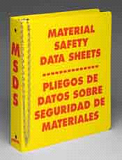 |
|
??
4.3 IMO Dangerous Goods Declarations (PDF)
?
|
This form is mandatory for all shipments by sea and meets SOLAS requirements 74 Chapter VII Reg.5; MARPOL 73/78 ANNEX III Regulation 4, and IMDG Code General Instruction, Section 9.
?
Click HERE to download the sample of IMO Dangerous Goods Declarations.
|
|
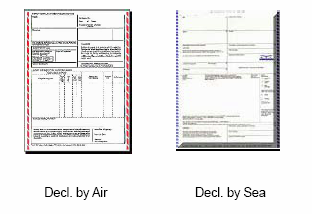 |
|
?
?
4.4 Container / Vehicle Packing Certificate (PDF)
?
When dangerous goods are packed or loaded into any container or vehicle, those responsible for packing the container or vehicle shall provide a "container/vehicle packing certificate" specifying the container/vehicle identification number(s) and certifying that the operation has been carried out in accordance with the conditions stipulated in the checklist.
?
Click HERE to download the sample of Container / Vehicle Packing Certificate.
?
?
4.5 Multimodal Dangerous Goods Form (PDF)
?
It is a document that is used when carrying dangerous goods on the vessel, the following fields has to be used;
?
1) Information on the product
2) The weight of the product
3) The packaging size
4) The vehicle stowage plan
5) Any other characteristics that the dangerous cargo has
6) Contact number in case something happens with the cargo
?
Click HERE to download the sample of Multimodal Dangerous Goods Form.
?
|
?
?
5.0 Shipper¡¦s Responsibility
?
?
?
?
|
5.1 Accuracy of Classification of Dangerous or Hazardous Cargo
?
The classification should be made by the shipper or consignor.
?
?
5.2 Suitability of Packaging for Use
?
It is shipper¡¦s responsibilities for checking suitability of packaging for use with certain contents according to appropriate regulations.
?
?
5.3 Correctness of Marking, Labeling and Placarding
?
Packages each containing dangerous goods should be legible and durably marked and labeled on the outside of the packagings with an identification of either the consignor or consignee, or both. Containers should be correctly labeled by the shipper prior dispatch to the port. Discharge port agents must ensure the labels are removed prior accepting the empties back into their yards. Dangerous and hazardous cargoes such as explosives and inflammables, or any other cargo of an objectionable nature are subject to carrier's option of acceptance and special booking arrangements.
?
?
5.4 Sufficiency of Packing
?
Shippers are legally obliged to store, stuff, and transport dangerous cargo according to IMO and governmental requirements. With respect to containers not packed by the carrier, the carrier shall not have any responsibility or liability for the safe and proper packing or stowage of the contents within the containers.
?
?
5.5 Preparation of Proper Cargo Documentation
?
Cargo documentation plays an integral part in the whole process. Strict regulations have been established to ensure that all dangerous goods requests are based on detailed inputs from the shipper/forwarder. A component of this is providing proper cargo documentation, including dangerous goods declarations, when shipping dangerous goods. A dangerous goods declaration allows the vessel to properly stow vessels in accordance with IMO requirements, also allows other parties (terminals, truckers, depots, etc.) to take precautionary measures required for handling the cargo appropriate supervision from authorities.
?
The shipper represents and warrants that the dangerous goods are properly described, marked, secured and packed in containers, and may be handled in ordinary course without damage to the said containers, containership, or to property or persons, and guarantees the correctness of the particulars, weight of each, and the description of the goods, and agrees to ascertain, and to disclose on shipment, any condition, nature, quality, ingredient or characteristic of the goods which might indicate that they are of an inflammable, explosive, corrosive, radioactive, noxious, hazardous or dangerous nature, or any condition, nature, quality, ingredient or characteristic that may cause damage, injury or detriment to the goods, other property, the containership or to persons.
?
Failure to file a dangerous goods declaration when required and/or any error in the declaration of dangerous goods may result in risks/damages to the environment and human lives, lack of proper care for the cargo and increased risk of cargo damage, fines and confiscation by the authorities and recovery action for damages/liabilities.
|
| |
|
|
|
|

